Interview Simiona Serban
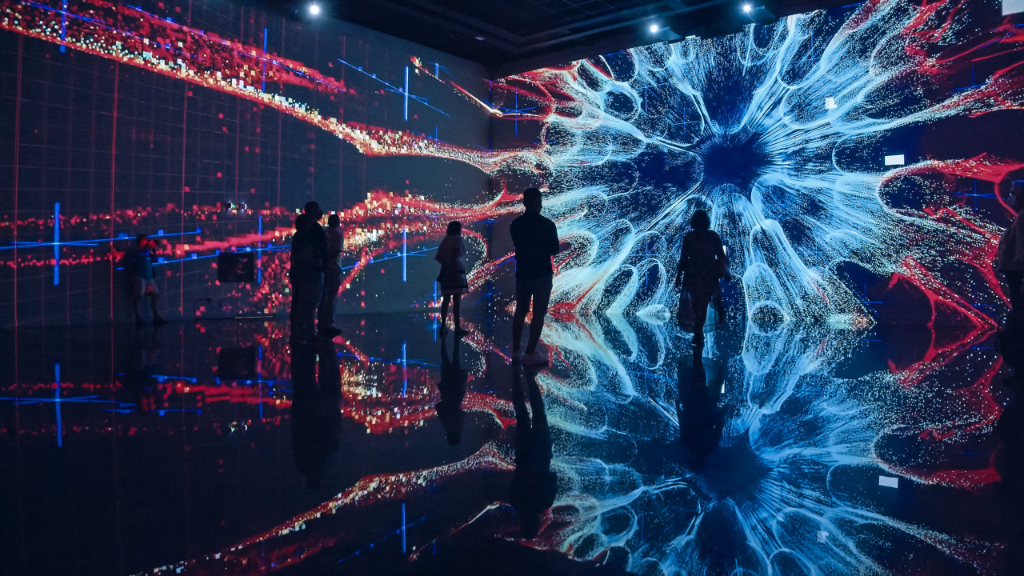
Design in our contemporary world dives into a pool of interdisciplinary and creative platforms; on this note, Nohlab studio is a multidisciplinary design studio focused on producing immersive experiences for the public, experimenting with art, design and technology. They build a bridge between the digital and the physical realities while examining the relationship of technology with art and design. It produces tools, designs and stories in which the connection between the human and technology reflects in many different ways.
In 2011 Candaş Şişman and Deniz Kader founded the studio, thus transitioning to a participative and sharing design process approach that started with taking a creative journey in search of the project’s ‘distinctive’ element; while they created their stories establishing a mutual relation between the perceptions and experiences.
Candaş Şişman and Deniz Kader avoid imagery and direct expression and intertwine knowledge production with experiences in their works with the aim that participants will discover a different experience every time and share their encounterings after having experienced the studio’s work. Part of their extensive design portfolio is the studio’s solo exhibition, a project titled – FLOW, AN EXPERIENTIAL JOURNEY. The installation was showcased to the public in 2021, in AKM, Istanbul, where a light-sound-motion-space experience was presented, allowing the viewer to dive into an immersive experience in 3 parts – Gate, Moment and Trace. Another exhibition – EVERYTHING – had its premiere at Atelier des Lumières in Paris & Bassin des Lumières in Bordeaux in 2021. It consisted of a 10 minutes immersive experience that showcased everything as it was; this meant that the viewers had the power to observe everything as they saw fit.
In giving the experience, their interpretations question all this existence and suggest new possibilities; the public got to experience and question the meaning of daily lives, ways of ascribing meanings to things, as well as embracing how much we as a society don’t know but that our curiosity might lead us to understand the constant state of transformation and probabilities we find ourself in, throughout our lives. In their own words, ‘Once we’re at peace with this fact, it means there’s still a lot to discover and be fascinated about.’ Currently in the works is another exciting project – 5 Movements – a 10 minutes immersive experience project for Hall des Lumières NY, the newest Culturespace Hall in Manhattan, as their contemporary opening show.
Now it’s time to put our curiosity to the test, dive into this pool of immersive experiences and learn more about their process, passions, the vision of the future for the industry and how we can better understand the field of immersive media since it is here to stay.
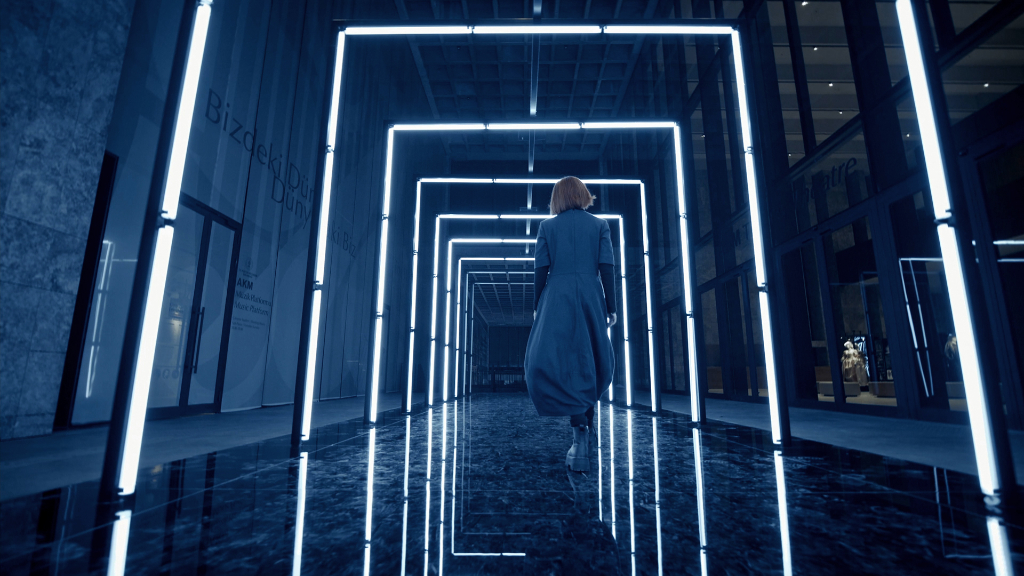
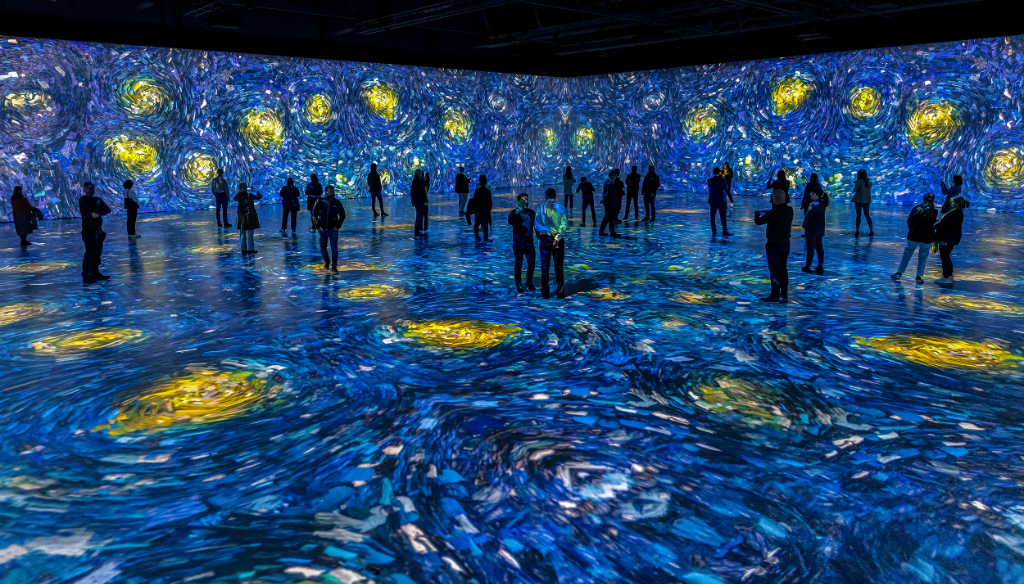
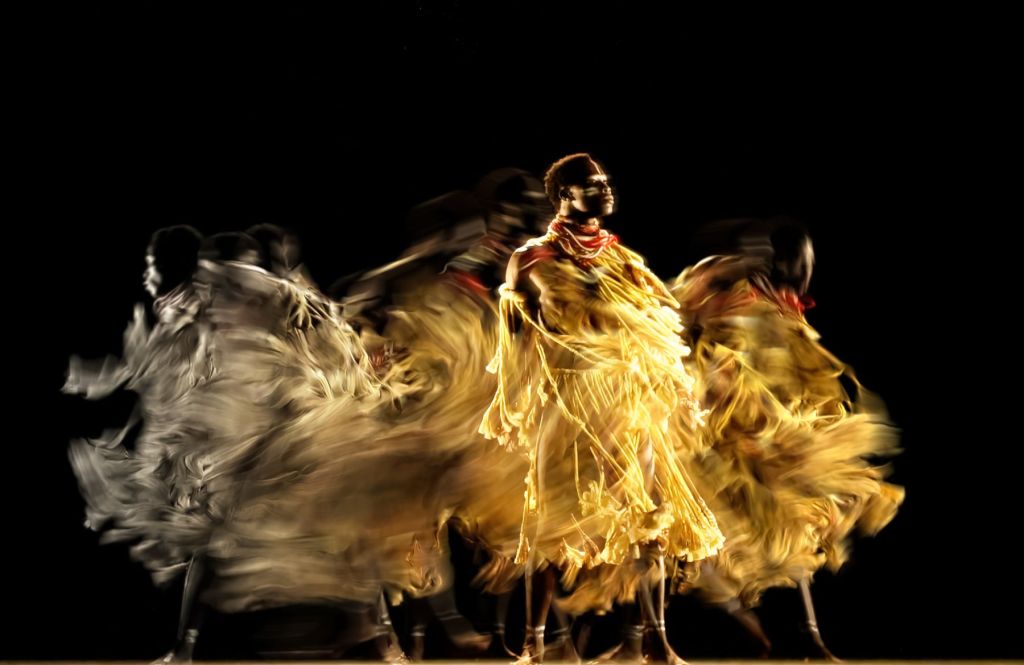
Right: 5 Movements
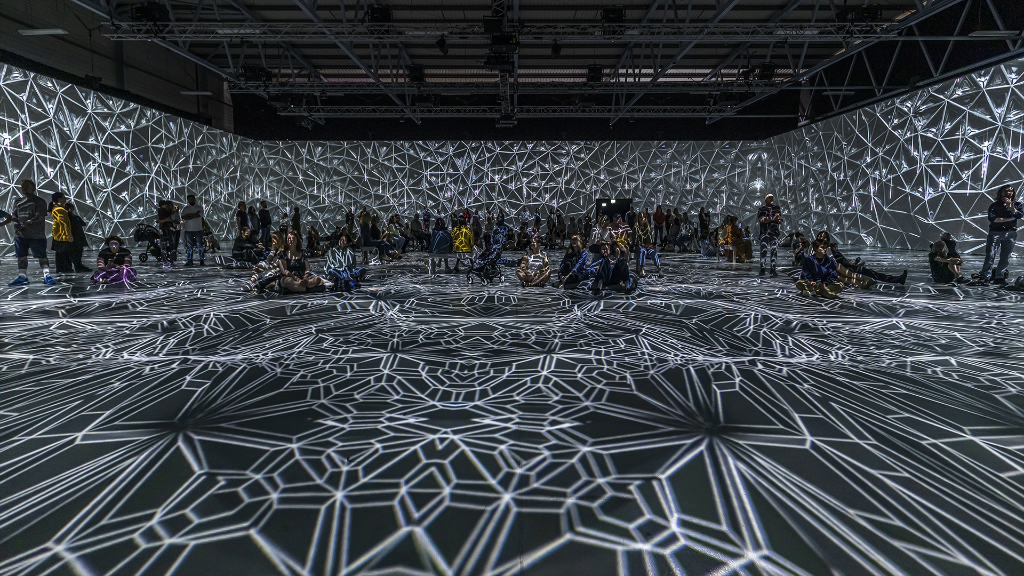
For those that are not familiar with the NOHLAB Studio’s creations, could you tell us more about the intellectual process that led you to found NOHLAB Studio, the interdisciplinary, immersive design studio?
We cannot say the whole process was a very planned thing. We experimented with things we wanted to try and do, and maybe we can call it the zeitgeist, and as we experimented, we realised it is also where the world goes and will go.
We feel like we were always dedicated to creating. We studied together in high school with a classical Fine Arts education and found the chance to do it in a more accustomed way, but we were always into technology too. We went on to study Animation in college afterwards. It was both challenging and very rewarding doing that in the second half of the 90s and 2000s when the Internet was only becoming very public, and there were only a bunch of reachable tools allowing us to do what we sought. We came across like-minded people and further opportunities to actually discover what we wanted to do.
So, what made us go into the multidisciplinary immersive design world at some part of our journey has been that, both consciously and unconsciously, our observations and executions led us to a point where the world has also reached. This is a point where the disciplines intertwine, and they create new possibilities together. Things turn into an experience-based structure from a knowledge-based structure. This is valid for many areas besides art and design, like education, advertisement, entertainment, etc. So what we wanted to do and where the world went intersected. And this has been very intuitive.
The interdisciplinary approach to your practice is visibly present in all of your projects, as well as your participative sharing processes. What attracted you to this form of expression, and what do you aim to achieve with your creations?
We were first attracted to the interdisciplinary approach because it allows for a more holistic and complete understanding of a problem or topic. We think it is essential to have different perspectives when trying to solve a problem, and the interdisciplinary approach allows for that. We also believe that it is important for people to see and understand the connections between different fields, and the multidisciplinary approach also allows for that.
We aim to understand problems and topics better and to create links between different fields. We enjoy working with different disciplines and exploring new ways of seeing things. We think it’s important to be open to new ideas and ways of thinking, and we believe that using an interdisciplinary approach allows for a more holistic view of the world. This also brings new possibilities and creative ideas that we might not think of by ourselves and opens up to new discoveries. This is like scientists experimenting and opening up new areas, and it excites us a lot.
We also think it’s important to be able to share your work with others, and I think that using a participatory sharing process helps to achieve that. Aside from the crew, it’s exciting to create experiences that everybody can observe and participate in 360 degrees. When you create environments that participants can interact with on their own, you feel refreshed and mesmerised when the environment you designed shapeshifts into something different, sometimes into something you did not foresee when you designed. We also think participation is a method that ignites the empathy notion in humans and makes them keep being in the moment so that the experience can be more relaxed and intense for the person.
How do you conceptualise the stories you want to tell, and how would you define your design process?
We turn the concepts we want to convey into stories rather than conceptualising the stories. In other words, the starting point is usually not the story itself but our conceptual and sensual thoughts on a more abstract level. We turn these into an immersive experience using various elements of experience design and using contemporary storytelling methods. Turning the concepts dwelling in our minds into stories, concepts especially like existence, physics, future, nature, and reality, we try to associate with various aesthetic approaches and methods we have at hand, protecting our artistic language.
In this connection network, anything that could be meaningful in terms of experience or conceptual organic associates. For example, light dispersing through a space and an abstract element can support each other, or the structure/fiber of the sound frequencies in a space can overlap with another storytelling point. So, when you design a 360-degree experience, each human sense and perception can become an instrument for us. We use these instruments to compose an experience, decide when and how to use them, and how they can weave a story out of our concept.
What is your vision for the future of experiencing artistic expression?
Well, it will be completely different; there’s no escape from that. We should now be open to this idea and accept that the evolution of humans and living beings is based on this foundation. Change has always happened and will always happen. Many things we’re used to knowing have not always been like this; we were not always like this. Especially when it comes to perception, timelessness and spacelessness will take the place of time and space as we know them because we’ll arrive at a point where we live in a fully digitalised reality. And this would be possible by our consciousness going out of our physical bodies and being inserted into a virtual kind of reality.
In addition, when we look into our evolution process, we can observe how organic evolution started to turn into synthetic evolution. Humankind can take control of evolution now, with the help of biotechnologies. This, of course, brings a god-like power. Also, questioning our limited perceptions enables us to design our own perceptions and bodies. These possible developments will change the perception of art and design as a whole. Artists and designers can create different designs of reality and ways of perception. And this will enable us to perceive art and design as more cognitive and corporeal than ever and be entirely inside the artistic designs rather than only being observers of them.
FLOW, AN EXPERIMENTAL JOURNEY, your studio’s solo exhibition in AKM, Istanbul, revolves around a light-sound-motion-space experience where the viewer can dive into an immersive experience in 3 parts – Gate, Moment and Trace. Can you tell us more about the driving force behind this project and how you could create synergy between key elements of the project?
It’s always both a pleasure and a challenge to solve how to combine all the elements of an experience in a meaningful way and create the hybrid experience we seek for. The main goal of this project was to kickstart the much-anticipated reopening of a prominent cultural center in Turkey with an immersive exhibition that could reflect the building’s past, present and future and its cultural importance. The elements of time and timelessness, building a new space in connection with the former one and combining all of these elements in human perception instantly clicked with us.
To do that, we formed a concept where we played with the idea of time. To draw the journey’s path, we used three different installation types representing three distinct phases of time, all in connection with the history of the space. The exhibition space outside had three floors, so we also had the chance to form the choreography of a journey from past to future on three different levels, with a gap between restarting and refreshing for the following part.
The first section, GATE, representing the past, was formed as a light tunnel that invites people in with a special light and sound choreography. In addition to recordings from PAST performances in the concert hall of the cultural center, music and colours are used as symbolic representatives of its place in Turkey’s cultural memory. So the fragments of this iconic building come together to create an experiential journey.
In the second section of the experience, MOMENT, visitors found the chance to experience the Moment they are in through twin LED tower corridors they pass. A spatial choreography formed by more contemporary expressions in sound and light with visuals referring to the iconic façade of the building and letting people experience NOW as a whole, building a bridge between the past and the future.
At the end of the journey, a concave structure of LED towers, covered by two-way mirrors, offered an interactive experience area. Called TRACE, the installation acted as both a mirror and a visual depending on the visitor’s position. People could guide the sound and visuals representing the future with their body movements. Not only do they symbolically make the instantaneous transfer from the present to contacting the future, but also they leave a Trace of reaching out to the future with their momentary acts. So in a way, their Trace prevails in the FUTURE. Creating a hybrid reality is important for us, so using physical and digital elements to modify human perception is always interesting. Here we also aimed to achieve more of that hybrid experience, including physical elements in connection with the digital world, presenting the digital in more atypical or uncommon mediums than people are used to.
Last May, in RDS (Dublin), you opened EVERYTHING and JOURNEY, 35 minutes of immersive experience alongside another captivating experience, VAN GOGH, AN IMMERSIVE JOURNEY, where the curious public was able to experience different perspectives while challenging their spatial perceptions through art, design and technology. Since all these intricate design experiences opened simultaneously in the same location, can you tell us more about the exhibition flow? Also, what was your general experience with the whole design implementation process?
The three works did not exhibit simultaneously in separate rooms but one big immersive area. And so the exhibition already had 35 min. flow, starting with Journey, then presenting Van Gogh Experience, and ending with Everything. With the first episode, JOURNEY, the audiences got to see the multi-award-winning experience, which was a part of the Immersive Art Festival at Atelier des Lumieres. We are a light particles in this experience. First, we are born into the blank space, then travel through several layers of the eye, and the brain translates us into perceivable solid objects.
After that, VAN GOGH, AN IMMERSIVE JOURNEY, starts. Van Gogh’s artworks and life are transformed into an audiovisual storytelling in four parts, and this experience has more variety in spatial and storytelling approaches. We begin with witnessing many episodes in his life and work through his paintings, and sometimes we experience some events through our personal spatial experience. A good example is in an episode where Van Gogh moves to South France, “searching for the light,” following his distaste for dark Parisienne weather. As the audience, we start to chase and follow the light with him and live his experience in capturing the Sun. Or, as in the scene where using only sound design and simple scenography of solid yellow colour, we experience the moment right after he argued with Gaugin and cut his ear as if we were him.
But the main highlight for us is more in the second half, where we experiment more with re-interpreting classical paintings. Paintings turn into imaginary landscapes as if we stroll inside a 20000 square feet wide painting in 360 degrees in real life. The AI part in the last episode is the most spectacular in our taste, as it makes use of an entire catalogue of over 2000 artworks: Paintings, drawings and letters. By categorising and analysing them, they learn Van Gogh’s style and colour palette and generate paintings in his style. It’s a one-of-a-kind experience.
EVERYTHING, the closer, is an immersive experience about literally “everything”, observes everything as it is, questions all this existence, and suggests new possibilities in three parts. First, through the eyes of a candid narrator, who follows the storyline in sync with us, visuals & sound follow a narrative where science, philosophy and metaphysics converge. We observe elements that construct what we call our lives and ways of ascribing meanings to things. This way, we can grasp how the vast system of existence enveloping us is prone to many questions. Here we follow a narrative, but we are also an organic part of the same narrative.
This exhibition is now over in Dublin, but we hope to redo it again in another location, so we still would want to give some tips for future participants and general immersive experiences. The main advice would be not to approach this as a classical art piece, movie, or performance. It’s an experiential exhibition, so it is designed to manipulate the space and time perception of people from the beginning. So the participants should be aware of that and try to experience the environment we created and presented to them in the most extensive way possible.
For example, instead of just standing on one spot and watching only a certain area of a wall or floor or listening to the sound only from a certain corner, they should go around, form their journey, and constantly change their perspective and perception inside the experience. Stop at one place, lay down in another, sit sometimes, stroll at other times. This body movement reveals more of the spatial feeling of the experience, and they would have the chance to discover their environment just as curious kids discover the possibilities of their surroundings. Just try to be in the experience and catch the momentary flow of perception and senses.
You have another immersive experience project planned, currently in the developing stage – 5 Movements – a contemporary installation capable of guiding its visitors into the exploration of space and time using five different types of motion. How is the design process going, and what did curious minds discover when the exposition opened in Hall des Lumières, NYC?
We tailored for this new huge digital exhibition space, spread over two stories inside the beautiful historic building, formerly a bank at the heart of Manhattan. 5 Movements, in its core, is a 10-minute immersive audiovisual experience exploring the relationship of human body movements with space and time, using five different types of motion chiselled by five performers. So, in a nutshell, our curious participants are experiencing the transformation of a huge, historical architecture into a completely new space using digital elements. And they can expect this experience to be an eclectic one, as manifold as it would get: A mix of the movements of a human body with space and time perception, various cultures and music and dances, both the classical and contemporary narratives. And their experience is the uniting bond of all these elements.
By capturing fleeing phases of performers’ movements in succeeding phases of motion, the emotion and essence of each motion are incorporated into three dimensions. The experience connects the dots between traces of movements, a phenomenon that human senses are most often unable to perceive in real-time. Inspired by several different types of dance, from traditional tribal dances and ballet to street style, hip-hop, and contemporary performances, five music movements unify various world beats, including African, Contemporary Classic, Electronica, Instrumental Hip-hop and Asian. All this diversity from different parts and times of the world becomes one in an immersive motion choreography through the kinetic displacement of bodies in space with time.
What is your chief enemy of creativity?
For an artist, the biggest vice is anything that would keep you repeating yourself; most artists & designers create only variations based on certain techniques and styles. Lingering on aesthetic and technical elements is another key vice. It causes you to look at everything from a narrow perspective. Creativity requires a wide perspective.
Only generating solutions for problems you’re presented with or only generating answers for questions others ask is also a big problem. This could end up in a certain level of creativity, but in the end, real artistic creativity only happens with the artist asks questions from within. Only then can the artist go back to self and create a unique creative language.
There are also worldly problems—for example, Time. Or mostly lack thereof. The extensive long periods of production make you lose your touch and excitement, or short periods do not give you time to think and better your design in the way you imagine. Both can keep you from realising what you created in your mind. Another factor is the funds. Or mostly lack thereof 🙂 You can design at many surpassing levels when it comes to our creation form, but it is very usual that they may not be the more affordable choice. And maybe, interestingly, it’s sometimes the technology itself, when it cannot respond to the needs of the design, or it’s more impractical than optimal. So maybe the technology that would realise our design is not even invented.
You couldn’t live without…
Creating, music, nature, science, curiosity, pause, observation, manipulation, experimentation, learning.






